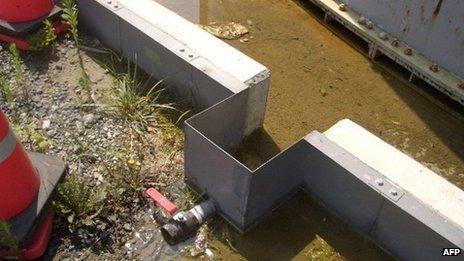日本原子能规制委员会日前将福岛核电站核污水泄漏事故级别从一级提高至三级,形容其为“严重事件”,并对东电公司应对这一事故的能力表示担心。国际核辐射事件分级表根据泄漏事件严重程度将其分成0至7级,7级为最严重。本周一,东电公司发现福岛核电站一处高辐射性污水储罐发生泄漏,预计已有300吨高辐射性污水泄漏。东电公司最近的一份报告显示,部分污水已渗入地表,部分或已流入附近的太平洋海域。东电检测发现,已泄露污水每小时的辐射释放量为100毫希沃特,这意味着,按照国际安全标准,如果一个人站在那里一小时内所受的辐射量将是核电作业人员一年内所能承受辐射上限的5倍。
2011年地震海啸使福岛核电站三处核反应堆冷却系统失灵,需要将水泵入反应堆帮助其冷却,同时也需要大量的储罐来存储这些带有高辐射性的污水。此前也发生过核污水泄漏事故,但此次泄漏事件是至今为止最严重的一次。

 |
|
Workers discovered the water was leaking from a tank on Monday |
Japan's nuclear agency has upgraded the severity level of a radioactive water leak at the Fukushima plant from one to three on an international scale.
Highly radioactive water was found to be leaking from a storage tank into the ground at the plant on Monday.
It was first classified as a level one incident on the International Nuclear and Radiological Event Scale (Ines).
But Japan's Nuclear Regulation Authority proposes elevating it to level three on the seven-point scale.
Japanese reports say it is a provisional move that had to be confirmed with the IAEA, the UN's nuclear agency.
This week is the first time that Japan has declared an event on the Ines scale since the 2011 earthquake and tsunami.
The move was announced in a document on the agency's website and was subsequently approved at a weekly meeting of the regulatory body.
The March 2011 tsunami knocked out cooling systems to the reactors at the plant, three of which melted down.
Water is now being pumped in to cool the reactors but this means that a large amount of contaminated water has to be stored on site.
There have been leaks of water in the past but this one is being seen as the most serious to date, because of the volume - 300 tons of radioactive water, according to Tepco - and high levels of radioactivity in the water.
Japan's Nuclear Regulation Authority (NRA) said it feared the disaster was "in some respects" beyond Tepco's ability to cope.
"We should assume that what has happened once could happen again, and prepare for more," watchdog chairman Shunichi Tanaka told a news conference. "We are in a situation where there is no time to waste."
He said Tepco had failed to spot the leak for days - maybe weeks - despite patrols that are supposed to check each storage tank twice every day. Workers had also left a tap open in the safety barrier that surrounds the base of the leaking storage tank.
That had allowed highly toxic water to trickle away into the ground. Latest reports from the plant suggest some of it may already have reached the nearby Pacific Ocean.
A puddle of the contaminated water was emitting 100 millisieverts an hour of radiation, Kyodo news agency said earlier this week.
Teams of workers at the plant have surrounded the leaking tank with sandbags and have been attempting to suck up large puddles of radioactive water.
But it is a difficult and dangerous job. The water is so radioactive that teams must be constantly rotated and it is clear that most of the toxic water has already disappeared into the ground.
Under the Ines, events have seven categories starting with Level 0 ("without safety significance") and Levels 1-3 denoting "incidents" while Levels 4-7 denote "accidents".
The triple meltdown at Fukushima two years ago was classed as a level 7 incident, one of only two nuclear events ever rated that highly - along with the 1986 Chernobyl disaster in the former Soviet Union.
(Source: BBC News)
相关阅读

(中国日报网英语点津 实习生 马国佳,编辑 Helen )